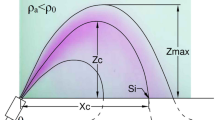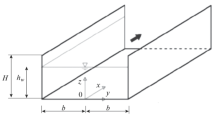Abstract
The flow characteristics of the subcritical and supercritical flows over an unconfined free overfall in a rectangular channel are presented with experimental data available in the literature. The experimental observations cover a wide range of flow rate on mild, steep and adverse slopes. The dependence of the ratio of the brink depth to the critical depth according to several flow parameters is examined. The relation between the flow rate and the brink depth ratio is both explicitly and implicitly demonstrated. The location of the critical depth for subcritical flows upstream of the brink is also investigated. It is concluded that the location of the critical depth for subcritical flows depends on the Froude number, the channel bed slope and the Manning roughness coefficient. Furthermore, it is observed that there is a significant similarity of the water surface profiles in the immediate upstream vicinity of the brink of the subcritical and supercritical flows.









Similar content being viewed by others
Abbreviations
- a u :
-
Unit conversion factor
- b :
-
Width of the channel
- Fr:
-
Froude number
- g :
-
Acceleration due to gravity
- k s :
-
Nikuradse’s sand roughness
- l p :
-
Critical depth distance from the brink in subcritical flow condition
- L :
-
Length dimension
- M :
-
Mass dimension
- n :
-
Manning’s roughness coefficient
- R :
-
Reynolds’s number
- R h :
-
Hydraulic radius
- S c :
-
Critical bed slope
- S o :
-
Bed slope
- q :
-
Discharge per unit width
- r 2 :
-
Correlation coefficient
- RMS:
-
Root mean square error
- T :
-
Time dimension
- X :
-
Dimensionless horizontal length
- x :
-
Coordinate points of water surface in horizontal
- Y :
-
Dimensionless vertical length
- y :
-
Coordinate points of water surface in vertical
- y c :
-
Critical depth
- y e :
-
Brink depth
- y o :
-
Upstream normal depth
- y p :
-
The length of the profile at the immediate vicinity of the brink
- ρ :
-
The density of the fluid
- Ф :
-
Dimensionless parameter
- μ :
-
Viscosity
References
Ahmad Z (2003) Quasi-theoretical end-depth-discharge relationship for rectangular channels. J Irrig Drain Eng ASCE 129(2):138–141
Anderson MV (1967) Non-uniform flow in front of a free overfall. Acta Polytech Scand 42:1–24
Bauer SW, Graff WH (1971) Free overfall as flow measurement device. J Irrig Drain Div ASCE 97(IR1):73–83
Beirami MK, Nabavi SV, Chamani MR (2006) Free overfall in channels with different cross sections and sub-critical flow. Iran J Sci Technol Trans B Eng 30(B1):97–105
Chow VT (1959) Open-channel hydraulics. The McGraw-Hill, New York
Clarke NS (1965) On two-dimensional inviscid flow in a waterfall. J Fluid Mech 22:359–369
Davis AC, Ellett BGS, Jacob RP (1998) Flow measurements in sloping channels with rectangular free overfall. J Hydr Eng ASCE 124(7):760–763
Davis AC, Ellett BGS, Jacob RP (1999) Estimating trajectory of free overfall nappe. J Hydr Eng ASCE 125(1):79–82
Delleur JW, Dooge JC, Gent KW (1956) Influence of the slope and roughness on the free overfall. J Hydr Div ASCE, M.Sc. Thesis, Middle East Technical University, Ankara. 82HY(4): 30-35
Dey S (2000) End depth in steeply sloping rough rectangular channels. Sadhana 25(1):1–10
Dey S (2002) Free overfall in open channels. Flow Meas Instrum 13:247–264
Ferro V (1992) Flow measurement with rectangular free overfall. J Irrig Drain Eng ASCE 118(6):40–44
Fırat CE (2004) Effect of roughness on flow measurements in sloping rectangular channels with free overfall. M.Sc. Thesis, Middle East Technical University, Ankara
Gordon NG, Mcmahon TA, Finlayson BL, Gippel CJ, Nathan RJ (2204) Stream hydrology: an introduction for ecologists. Second edition, John Wiley, p 444, (page 463)
Guo Y (2005) Numerical modeling of free overfall. J Hydr Eng ASCE 131(2):134–138
Hager W (1983) Hydraulics of plane free overfall. J Hydr Eng ASCE 109(12):1683–1697
Heasted M, Dyhouse G, Hatchett J, Benn J (2003). Floodplain modeling using HEC-RAS, First edition, Heastes Press, Waterbury. ISBN:0-9714141-0-6
Khan AA (1999) Modeling rectangular overfalls using Boussinesq equations. Proc Inst Civ Eng Water Marit Energy 136:77–80
Khan AA, Steffler PM (1996) Modeling overfalls using vertical averaged and moment equations. J Hydr Eng ASCE 122(7):397–402
Kraijenhoff DA, Dommerholt A (1977) Brink depth method in rectangular channel. J Irrig Drain Div ASCE 103(2):171–177
Kutlu I (2005) The behaviour of flow in the immediate vicinity of a sloping rectangular channel with free overfall. M.Sc. Thesis. The Middle East Technical University, Ankara, Turkey
Lienhard (V) JH, Lienhard (IV) JH (1984) Velocity coefficients for free jets from. sharp-edged orifices. J Fluids Eng 106:13–17
Marchi E (1993) On the free overfall. J Hydr Res IAHR 31(6):777–790
Montes JS (1992) A potential flow solution for the free overfall. Proc Inst Civ Eng Waters Marit Energ 96:258–259
Peakall J, Warburton J (1996) Surface tension in small hydraulic river models-the significance of the Weber number. J Hydrol (NZ) 35(2):199–212
Rajaratnam N, Muralidhar D (1968) Characteristics of the rectangular free overfall. J Hydr Res IAHR 6(3):233–258
Rajaratnam N, Muralidhar D, Beltaos S (1976) Roughness effects on rectangular free overfall. J Hydr Div ASCE 102(HY5):599–614
Rouse H (1936) Discharge characteristics of the free overfall. Civ Eng ASCE 6(4):257–260
Rouse H (1943) Discussion of energy loss at the base of the free overfall by WL Moore. Trans ASCE 108(2204):1383–1387
Simons DB, Senturk F (1992) Sediment transport technology water and sediment dynamics, Water Resources Publications, p 897. ISBN:(91-67534), see page 96
Southwell R, Vaisey G (1946) Relaxation methods applied to engineering problems, fluid motions characterized by ‘free’ streamlines. Philos Trans R Soc London Series A 240:117–161
Sterling M, Sharifi S, Knight DW (2010) The end depth ratio and principal component analysis. Proc Inst Civ Eng Water Manag 163(WM8):425–430
Strelkoff T, Moayeri MS (1970) Pattern of potential flow in a free overfall. J Hydr Div ASCE 96(4):879–901
Tigrek Ş, Öztürk HU (2006) Discharge predictions using ANN in sloping rectangular channels with free overfall. In: Seventh International Congress on Advances in Civil Engineering. October 11–13, Istanbul
Tiğrek Ş, Firat CE, Ger M (2008) Use of brink depth in discharge measurement. J Irrig Drain Div ASCE 134(1):89–95
Turan ÇK (2002) Flow measurements in sloping rectangular channels with free overfall. M.Sc. Thesis, Middle East Technical University, Ankara
Yen BC (2002) Open channel flow resistance. ASCE J Hydraul Eng 128(1):20–39
Author information
Authors and Affiliations
Corresponding author
Rights and permissions
About this article
Cite this article
Tiğrek, Ş., Kumcu, Ş.Y. & Ger, A.M. Scrutinization of Flow in the Immediate Vicinity of a Brink in a Tilting Flume. Iran J Sci Technol Trans Civ Eng 41, 213–220 (2017). https://doi.org/10.1007/s40996-017-0053-4
Received:
Accepted:
Published:
Issue Date:
DOI: https://doi.org/10.1007/s40996-017-0053-4




